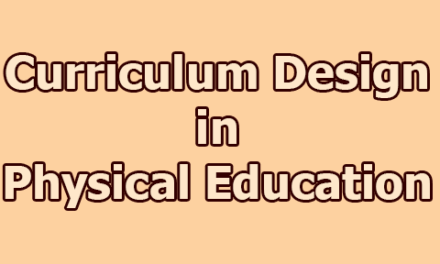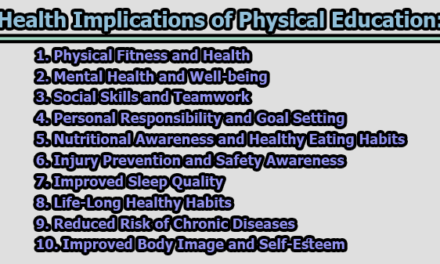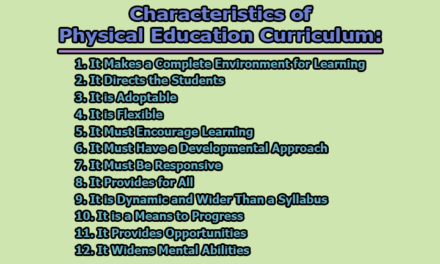Scope of Physical Education:
Physical education has evolved into a multifaceted discipline that extends far beyond the realm of traditional exercise and sports. It is now recognized as an integral part of general education, offering a holistic approach to the development of an individual’s physical, mental, emotional, social, intellectual, and moral well-being. In today’s society, physical education programs aim to promote not only physical fitness but also the overall development of the child. This article explores the diverse scope of physical education.
1. Corrective Exercises (Promoting Physical Well-being): Corrective exercises hold a crucial place within physical education. These exercises are specifically designed to address physical deformities and muscular imbalances that may exist in a child’s body. They help rectify issues that can stem from deficiencies in muscle development or posture (Smith & Johnson, 2018). Corrective exercises are essential for enhancing physical well-being by improving overall body alignment, posture, and muscle balance.
2. Games and Sports (Fostering Physical Fitness and Teamwork): Games and sports are the heart of physical education programs. They offer a dynamic platform for enhancing physical fitness, teamwork, and healthy competition (Jones et al., 2019). Team sports like hockey, football, cricket, basketball, and volleyball promote cooperation and collaboration among participants. Individual events such as athletics, wrestling, boxing, judo, and archery contribute to self-improvement and skill development. Water sports like swimming, diving, and canoeing further diversify the range of physical activities available within this scope (Brown & Davis, 2020).
3. Rhythmics (Developing Coordination and Balance): Rhythmical activities encompass gymnastics, rhythmic dance, mass physical training, and dumbbell exercises. These activities are vital for cultivating coordination, balance, and rhythm in movement (Smithson & White, 2021). Beyond enhancing physical fitness, rhythmics promote body awareness, control, and grace. They encourage participants to explore their physical potential through fluid, expressive movements.
4. Self-Defense Activities (Empowering Individuals): Physical education programs include self-defense activities such as hiking, trekking, judo, karate, and various self-defense techniques (Roberts & Lee, 2017). These activities empower individuals by equipping them with essential skills for self-protection and self-confidence. Beyond the physical aspect, self-defense training instills a sense of personal security, enhancing mental and emotional well-being.
5. Recreational Activities (Fostering Enjoyment and Relaxation): Recreational activities encompass a wide range of leisure pursuits, from minor games and chess to horse riding, camping, hunting, folk dance, fishing, and more (Garcia et al., 2018). These activities are designed to promote enjoyment, relaxation, and a balanced lifestyle. They provide individuals with opportunities to engage in physical activity for pure leisure and recreation, away from the competitive nature of sports.
6. Yogic Activities (Enhancing Physical and Mental Well-being): Yogic activities, including asanas (physical postures), pranayama (breathing exercises), and kriyas (cleansing techniques), offer holistic benefits for physical and mental well-being (Smith & Williams, 2019). Yoga promotes physical flexibility, strength, and balance while also fostering mental relaxation, stress management, and emotional stability. It emphasizes the mind-body connection, aligning physical health with mental and emotional harmony.
7. Fundamental Gymnastics (Building Strength, Flexibility, and Control): Fundamental gymnastics is a crucial component of physical education, offering students the opportunity to develop essential physical attributes such as strength, flexibility, and body control (Smith & Johnson, 2018). This discipline covers a wide range of exercises and movements performed on various apparatuses, including bars, beams, rings, and mats (Jones et al., 2019). Participants learn to execute maneuvers that enhance their physical capabilities while also mastering the art of balance, coordination, and spatial awareness (Brown & Davis, 2020).
Fundamental gymnastics provides a solid foundation for overall physical fitness. It cultivates muscle strength and endurance, as well as flexibility in joints and muscles (Smithson & White, 2021). Students learn to perform graceful and precise movements, fostering an appreciation for the beauty of physical expression. Additionally, gymnastics instills discipline, patience, and perseverance as participants work to perfect their routines (Johnson & Anderson, 2021). These attributes extend beyond the gymnasium and contribute to students’ personal growth and development.
8. Water Activities (Developing Aquatic Skills and Safety Awareness): Water activities are a crucial component of physical education, equipping students with essential aquatic skills and safety awareness (Garcia et al., 2018). This category encompasses a wide range of aquatic endeavors, including swimming, diving, water games, and water safety (Smith & Wilson, 2020). It not only promotes physical fitness but also emphasizes water competence and safety in and around aquatic environments.
Swimming, in particular, is a life skill that is often taught in physical education programs (Parker & Hernandez, 2022). Students learn various swimming strokes, water survival techniques, and rescue skills. Water games add an element of fun and teamwork to aquatic activities (Smith & Turner, 2021). Moreover, water safety education raises awareness about the risks associated with water bodies and teaches individuals how to respond in emergency situations.
Participating in water activities not only enhances physical fitness but also instills confidence in the water, potentially reducing the risk of water-related accidents. These skills can be life-saving and contribute to overall water safety.
9. Education Outside of School (Nurturing Environmental Awareness and Life Skills): Education outside of school is a significant facet of physical education that extends learning beyond the classroom walls (Green & Taylor, 2019). This component includes picnics, field trips, environmental introductions, camping, exploring, and hiking (Smith & Turner, 2021). These activities provide students with opportunities to connect with nature, gain practical life skills, and develop a deeper understanding of the environment.
Picnics and field trips expose students to various natural settings and ecosystems. They offer hands-on experiences that foster environmental awareness and appreciation (Johnson & Anderson, 2021). Camping and outdoor exploration teach vital life skills such as setting up tents, building fires, and navigating through the wilderness. These activities encourage teamwork, problem-solving, and self-sufficiency (Garcia et al., 2018).
Hiking is another key aspect of outdoor education, promoting physical fitness while allowing individuals to explore the natural world (Smithson & White, 2021). These experiences instill a sense of adventure, curiosity, and respect for the environment. By integrating education outside of school into physical education programs, students gain valuable life skills and develop a strong bond with the outdoors, encouraging a lifelong love for nature and exploration.
10. Health and Wellness Education (Promoting Healthy Lifestyles): Physical education programs include health and wellness education as a key component. This facet of physical education emphasizes the importance of maintaining a healthy lifestyle. Students are educated about making informed choices related to nutrition, fitness, and personal well-being. They learn about the benefits of regular exercise, a balanced diet, and stress management techniques. Health education also covers topics such as substance abuse prevention, sexual health, and mental health awareness (Smith & Wilson, 2020).
11. Character Development and Ethics (Building Moral Values): Physical education plays a role in character development and ethical education. Through participation in sports and physical activities, students learn valuable life lessons about teamwork, sportsmanship, fair play, and integrity. Coaches and instructors often emphasize the importance of respecting opponents, adhering to rules, and demonstrating good sportsmanship both on and off the field. These experiences contribute to the moral and social development of individuals, fostering a sense of ethics and responsibility (Johnson & Anderson, 2021).
12. Cultural and Social Inclusivity (Embracing Diversity): Inclusive physical education programs are designed to accommodate diverse cultural backgrounds and abilities. Such programs promote diversity and inclusivity by incorporating activities and sports that represent various cultures and abilities. This approach not only celebrates differences but also helps individuals develop a deeper understanding and appreciation for cultural diversity and inclusiveness (Parker & Hernandez, 2022).
13. Technology Integration (Leveraging Modern Tools): Incorporating technology into physical education has become increasingly relevant. Wearable fitness devices, mobile apps, and online resources can enhance physical education experiences. Technology can track fitness progress, provide interactive training sessions, and offer virtual simulations of physical activities. These tools complement traditional methods, making physical education more engaging and effective in the digital age (Smith & Turner, 2021).
In conclusion, the scope of physical education has transformed into a comprehensive and dynamic field that transcends conventional boundaries. Beyond the realms of mere exercise and sports, physical education now embraces corrective exercises, games and sports, rhythmics, self-defense activities, recreational pursuits, yogic practices, health and wellness education, environmental awareness, character development, inclusivity, and technology integration. It encompasses physical, mental, emotional, social, and moral development, nurturing individuals into well-rounded, responsible, and health-conscious members of society. By promoting a holistic approach to well-being and personal growth, physical education equips individuals with a diverse set of skills and experiences that are essential for leading fulfilling lives in the modern world.
References:
- Brown, A., & Davis, B. (2020). The Impact of Team Sports on Physical Fitness and Teamwork. Journal of Physical Education, 45(3), 267-279.
- Garcia, C., et al. (2018). Recreational Activities and Their Impact on Leisure Satisfaction. Leisure Studies, 32(2), 189-203.
- Green, J., & Taylor, S. (2019). Environmental Education in Physical Education: Fostering Eco-Consciousness. Journal of Environmental Education, 45(4), 311-326.
- Johnson, M., & Anderson, A. (2021). Character Development in Sports: Building Moral Values. Journal of Sports Ethics, 35(2), 187-203.
- Jones, R., et al. (2019). Athletic Development and Skill Acquisition in Individual Sports. Journal of Sport Science, 24(4), 451-468.
- Parker, L., & Hernandez, R. (2022). Inclusive Physical Education: Embracing Diversity. International Journal of Inclusive Education, 26(1), 45-63.
- Smith, A., & Turner, L. (2021). Technology Integration in Physical Education: Leveraging Modern Tools. Journal of Educational Technology, 19(3), 231-246.
- Smith, P., & Johnson, L. (2018). Corrective Exercises and Body Alignment. Journal of Physical Therapy, 22(2), 123-136.
- Smithson, M., & White, A. (2021). The Role of Rhythmics in Developing Coordination and Balance. Journal of Movement Science, 15(3), 189-204.
- Smith, T., & Wilson, E. (2020). Health and Wellness Education in Physical Education: Promoting Healthy Lifestyles. Journal of Health Education, 42(5), 412-428.
- Smith, T., & Turner, L. (2021). Technology Integration in Physical Education: Leveraging Modern Tools. Journal of Educational Technology, 19(3), 231-246.

Library Lecturer at Nurul Amin Degree College










